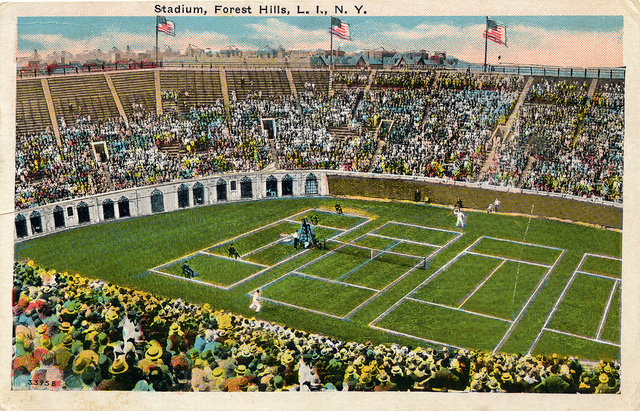At the legendary Forest Hills Tennis Stadium, birthplace of the U.S. Open, the ball may be back in court. A non-profit known as the Stadium Arts Alliance is one of the contenders that submitted a proposal, in response to the West Side Tennis Club’s Request For Proposals which ended on November 4th. The Stadium Arts Alliance would potentially lease the stadium and boost revenue for the WSTC. All particulars are not yet publicly known, but the US’ 1st concrete tennis stadium would likely undergo restoration and conversion to accommodate tennis matches and hockey, with music and art festivals in the warmer months.

A known alteration would be the installation of stadium seating in place of the authentic wood and iron grandstands, and a reduction of seating from 14,000 to 9,700. The dilapidated barbed-wire fence surrounding the property would be replaced by a traditional iron fence with brick posts, and the perimeters would be landscaped. A new walkway with an overhead brick archway with pitched rooflines and letters which read “WSTC Stadium.” Two replicas of the Stadium’s blue & gold glazed terra-cotta shields bearing the WSTC logo and “1923” would be installed on the gateway. Historic architectural features including the archways, eagles, shields, flagpoles, and cornice lines would undergo restoration.
Besides the Stadium Arts Alliance’s proposal, Cord Meyer proposed a new plan for condos, and other proposals also involved demolition for residential development. For a proposal to materialize, it would be subject to a review by the Stadium Committee, and in 2012, it would need to pass by a 2/3 vote of WSTC voting-eligible members, followed by approval of the Forest Hills Gardens Corporation.
The Stadium Arts Alliance is comprised of developer & President Kevin McCabe, and Chairman John Banks. Kevin McCabe is the founding partner and chief executive of the Aviator Sports & Events Center at Floyd Bennett Field, and John Banks is the VP of Government Relations for Con Ed, and a NY Public Library and MTA board member.
A seemingly greater path towards the stadium’s restoration became possible on November 3, 2011, when the WSTC elected Roland Meier as their new President over Kenneth Parker, who was reportedly anti-preservation. In August 2010, Cord Meyer Development proposed condos on the site of the stadium, and in protest, WSTC Tennis Committee Chair Roland Meier resigned from his position. Some neighborhood residents, countrywide preservationists, WSTC members, and tennis and music notables joined Rego-Forest Preservation Council in opposition to the condo plan. After the October 2010 vote, Kenneth Parker expressed his disappointment that the Cord Meyer plan was rejected by more than half of its voting-eligible WSTC members.
As chairman of the Rego-Forest Preservation Council, I wrote then that “Since the Forest Hills Tennis Stadium became endangered in July 2010 for typical condos, we have advocated for the historic stadium’s preservation and creative-reuse as a mixed-use venue, to benefit the greater community and the WSTC. We will continue to hold public relations campaigns, conduct outreach, coordinate petition drives and letter campaigns, and meet with elected officials and other influential parties. We have maintained a dialogue with some tennis buffs, preservationists, some celebs, & President Obama’s Advisory Board on Historic Preservation, which supports preservation and reuse. On behalf of Rego-Forest Preservation Council, I submitted a comprehensive city landmark bid in July 2010, and a bid for the State & National Register of Historic Places in summer 2011, in which the latter would likely generate more funding for restoring (and ultimately reusing) the stadium, if approved. We will support any plan that encompasses tennis, music and art festivals, and restores the iconic features of the iconic Stadium. There is always hope towards preserving and reusing our historic sites, as long as there is creativity, dedication, and proactive teamwork. Mixed-use creative revitalization and restoration for our country’s 1st concrete tennis stadium, and home to firsts in the tennis and music world, will convey historic pride, create jobs, and be a boost to our quality of life, character, property values, and local business, as well as become a 21st-century family destination.”
President Obama’s Advisory Board on Historic Preservation admitted that the NYC Landmarks Preservation Commission “irked its public duty,” by not calendaring the stadium for a public hearing. Rego-Forest Preservation Council feels the LPC has a “double-standard” when it comes to Queens, since under the Landmarks Law’s architectural and cultural provisions, the Stadium has the criteria for city landmarking, and it mentions nothing about a site’s physical condition as a means for rejection. Sites in worse physical condition in Manhattan have been heard, landmarked, and restored. If it becomes a State & Federal landmark through NYS Historic Preservation Office (the Register), the West Side Tennis Club and any potential partner or owner can apply for federal tax credits, state grants, as well as other funds for repairing the stadium.
Previous Untapped coverage of the Forest Hills stadium include a history of the stadium and an Untapped-sponsored photographic walking tour.






